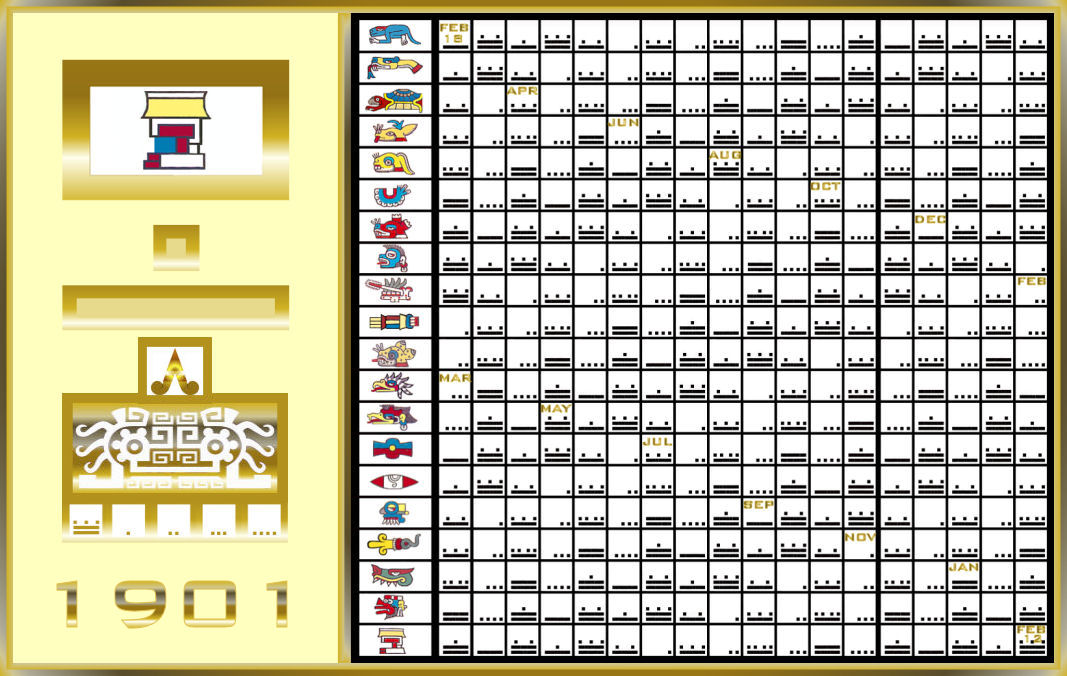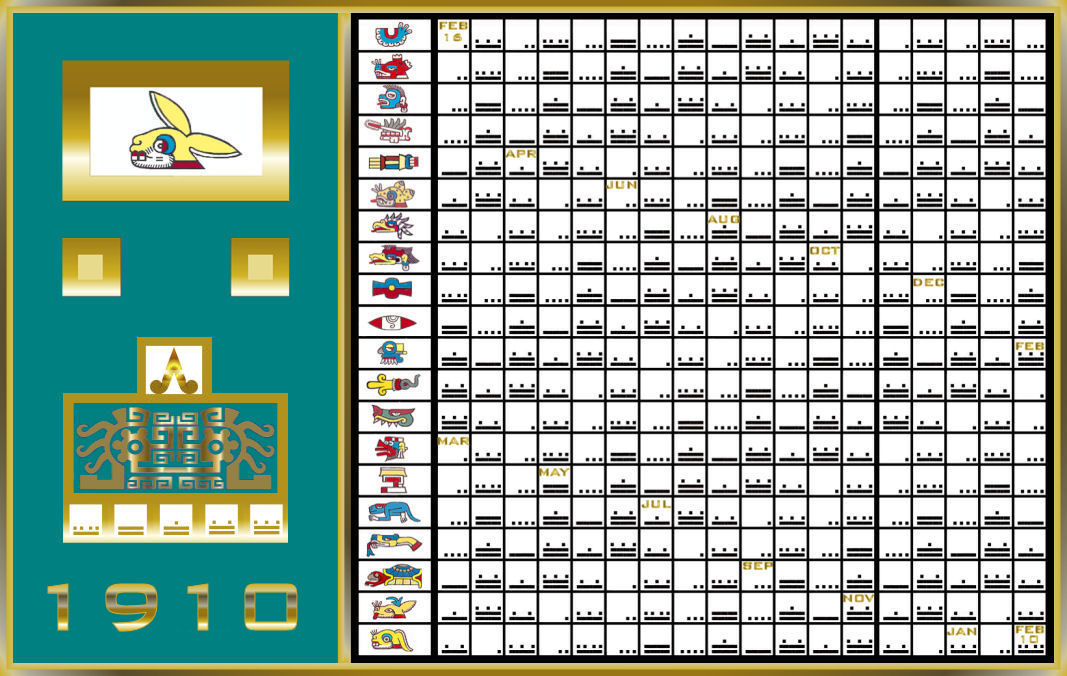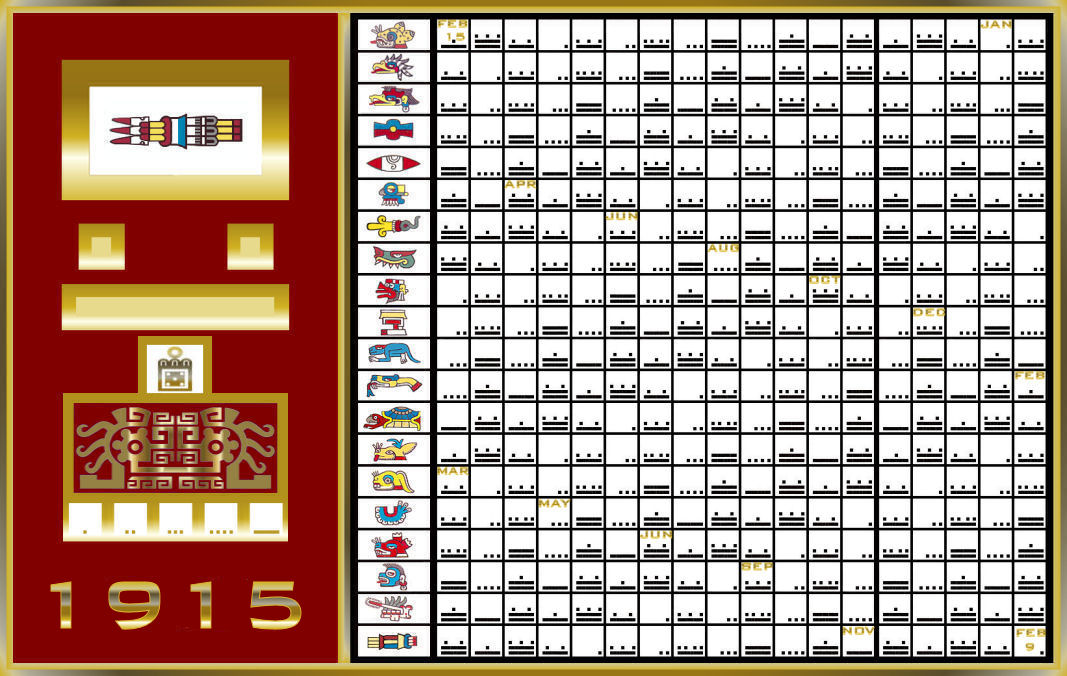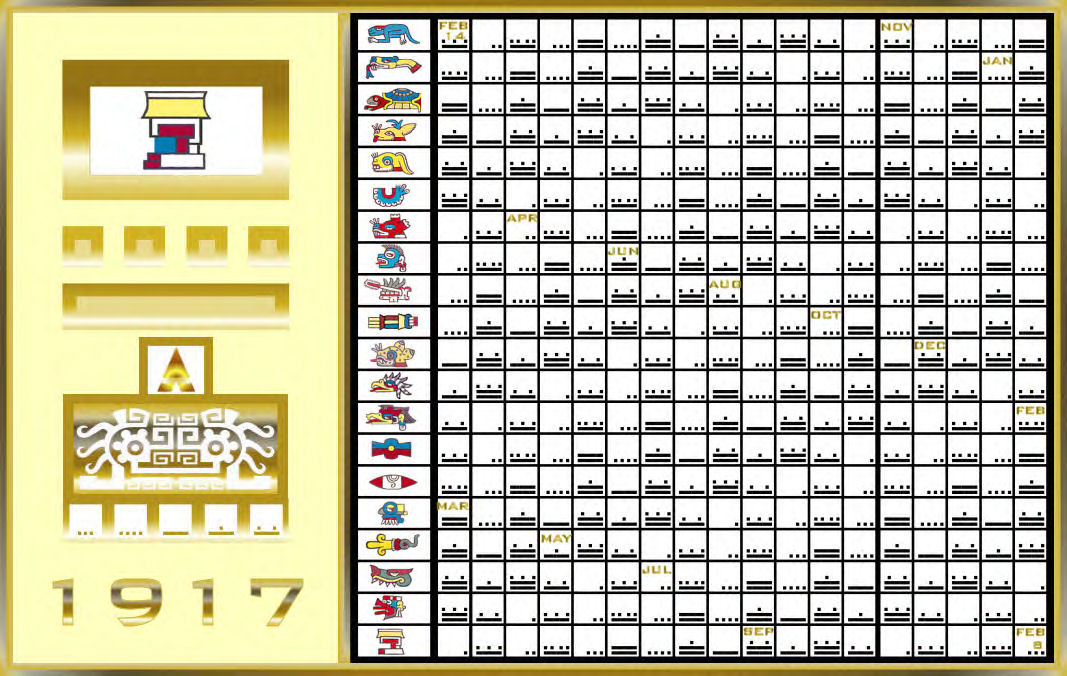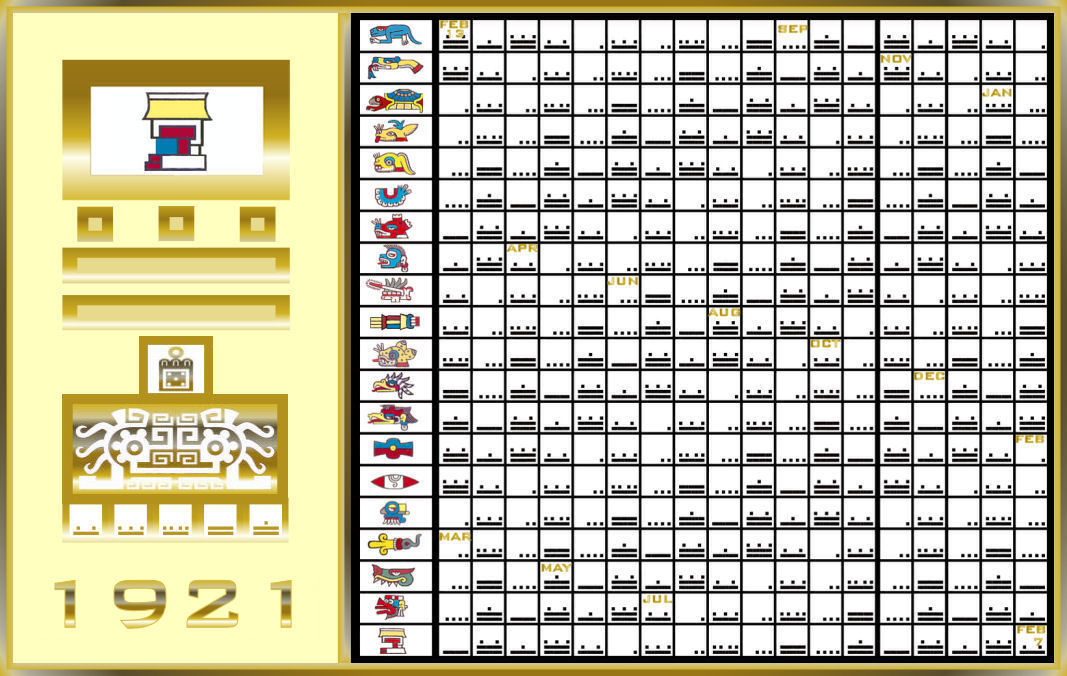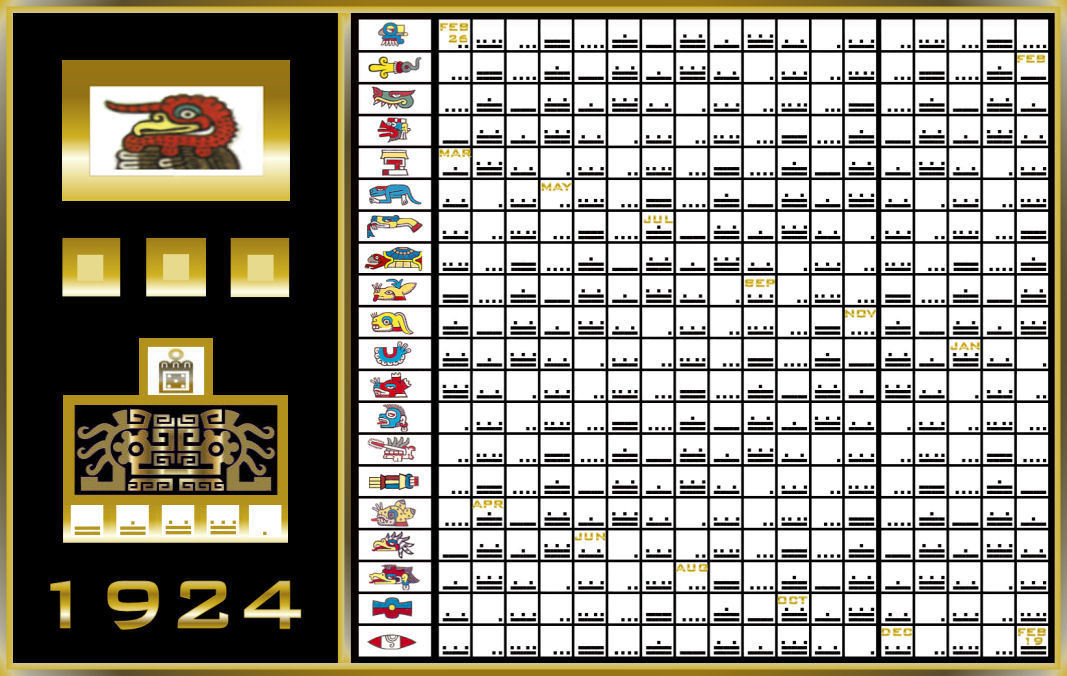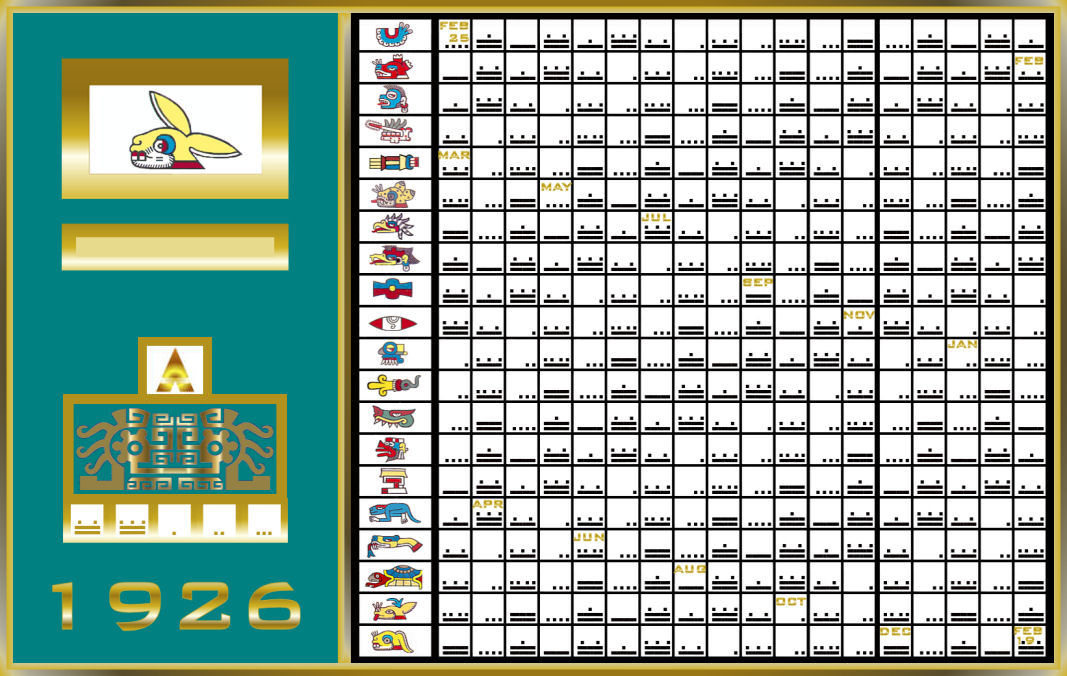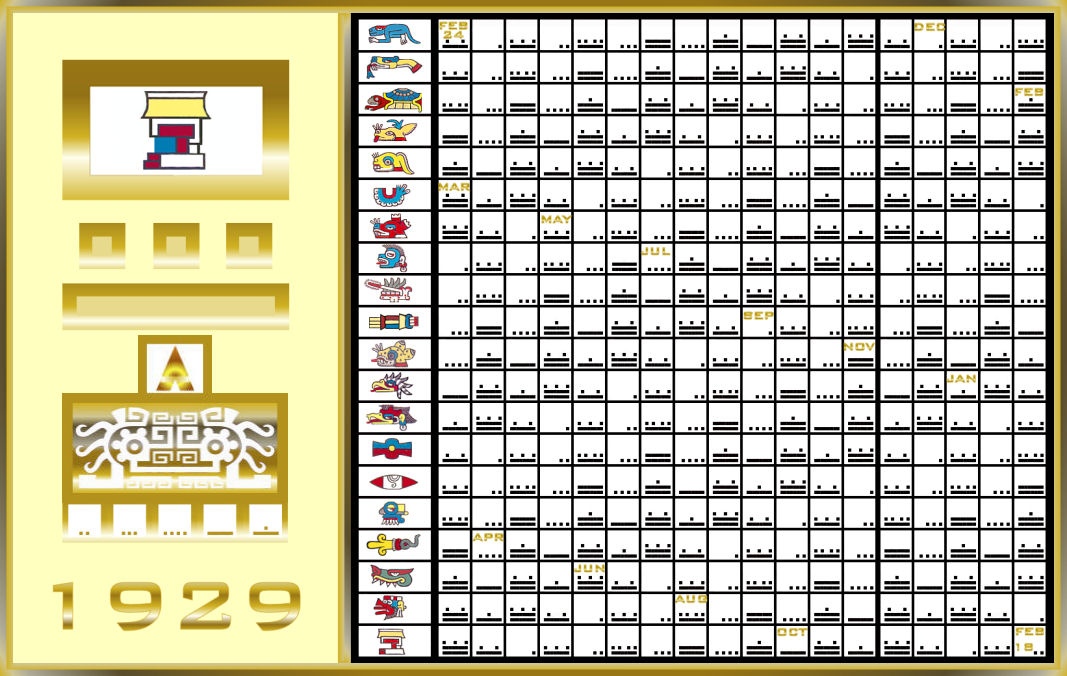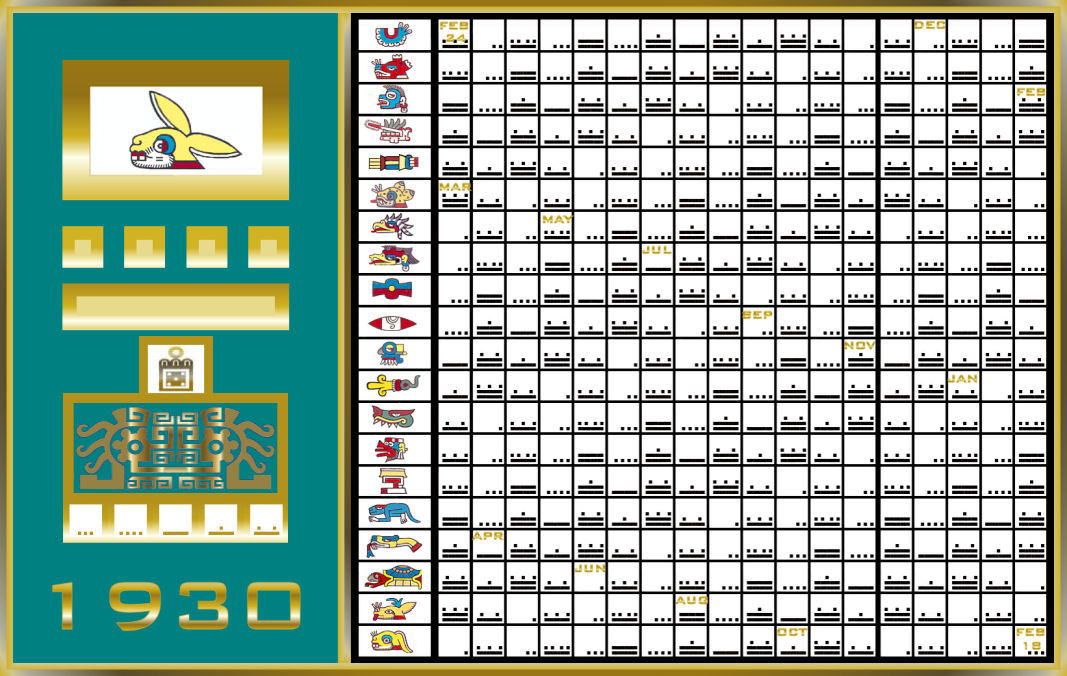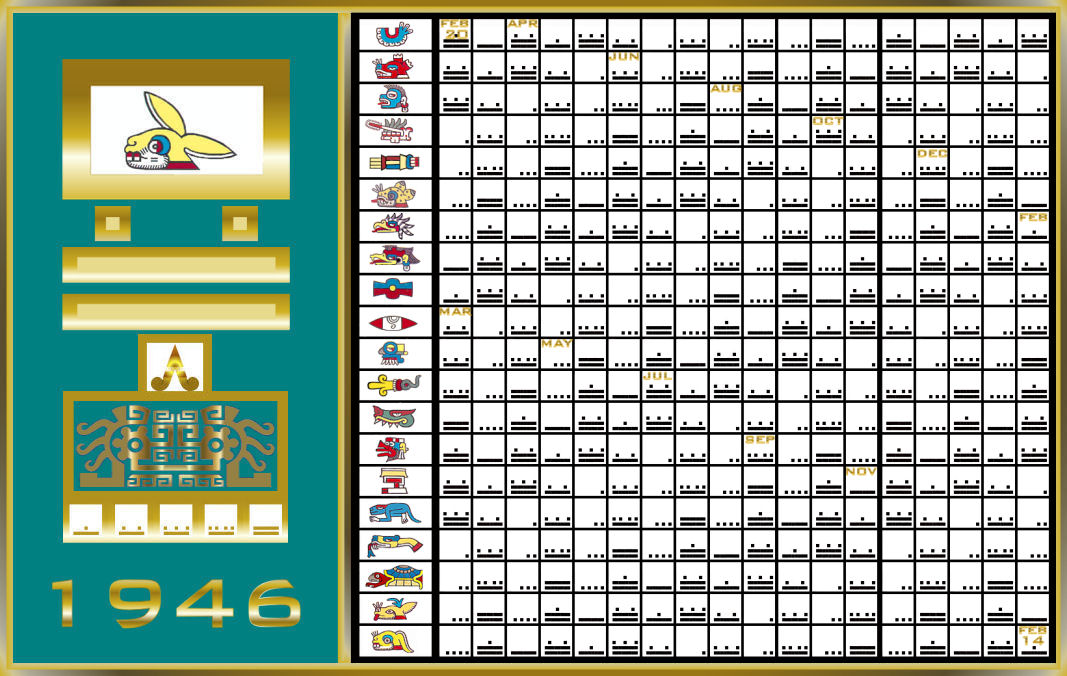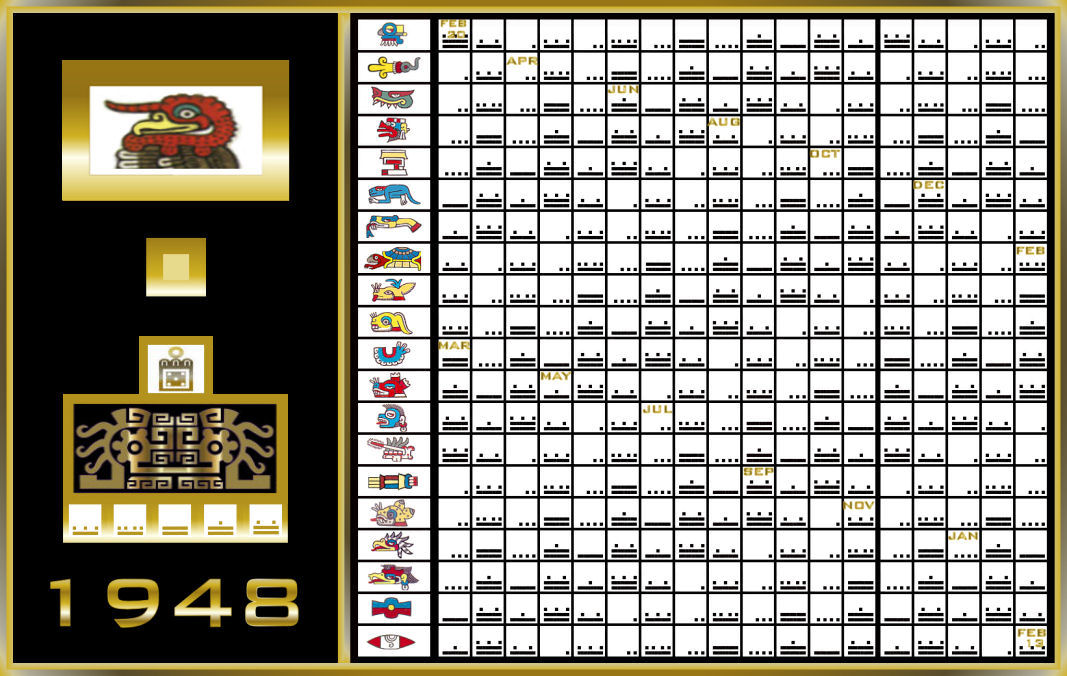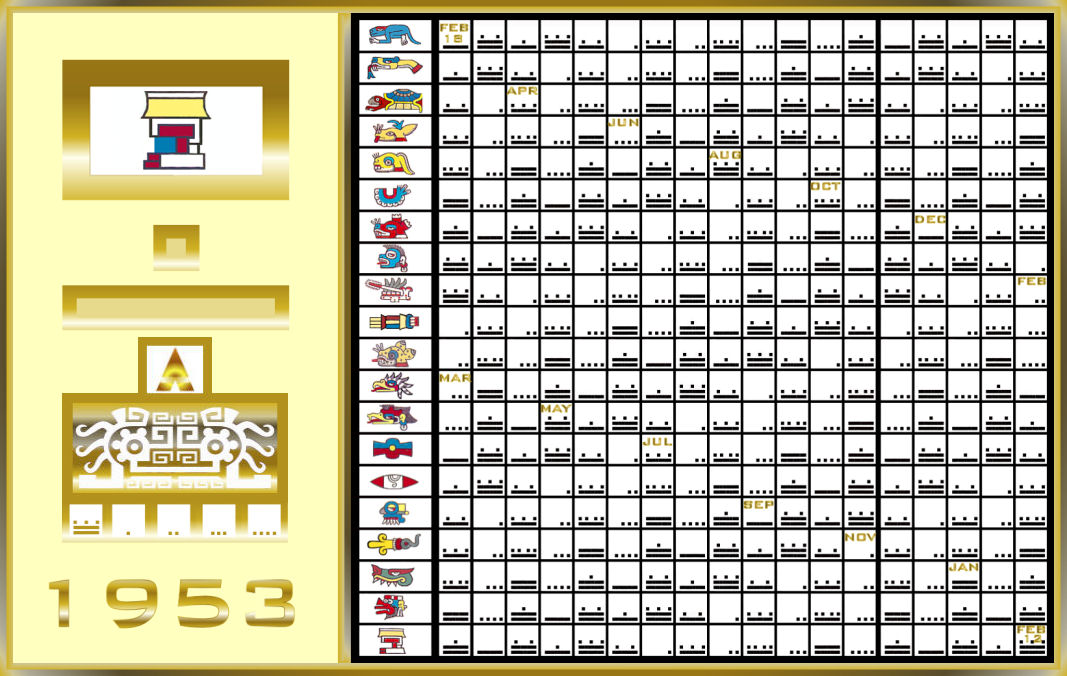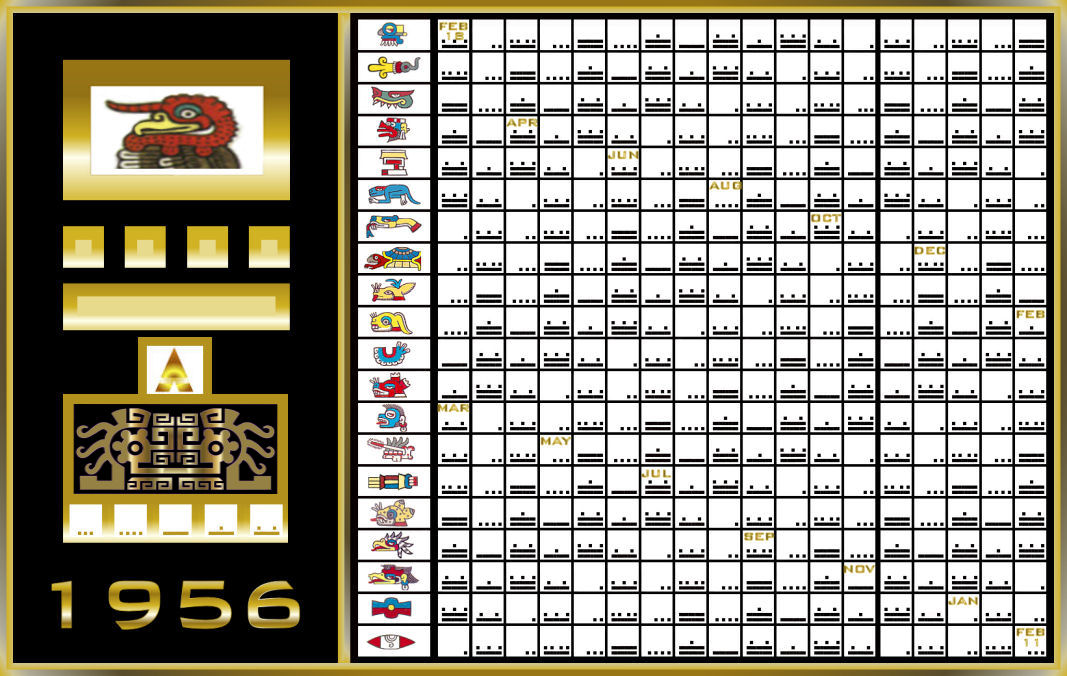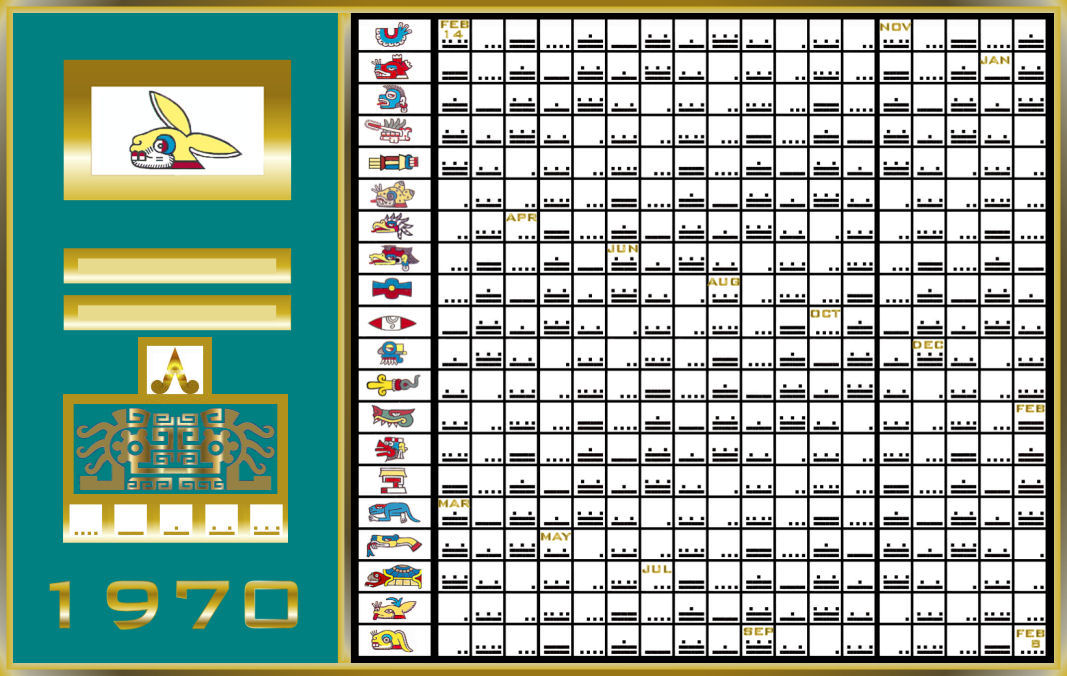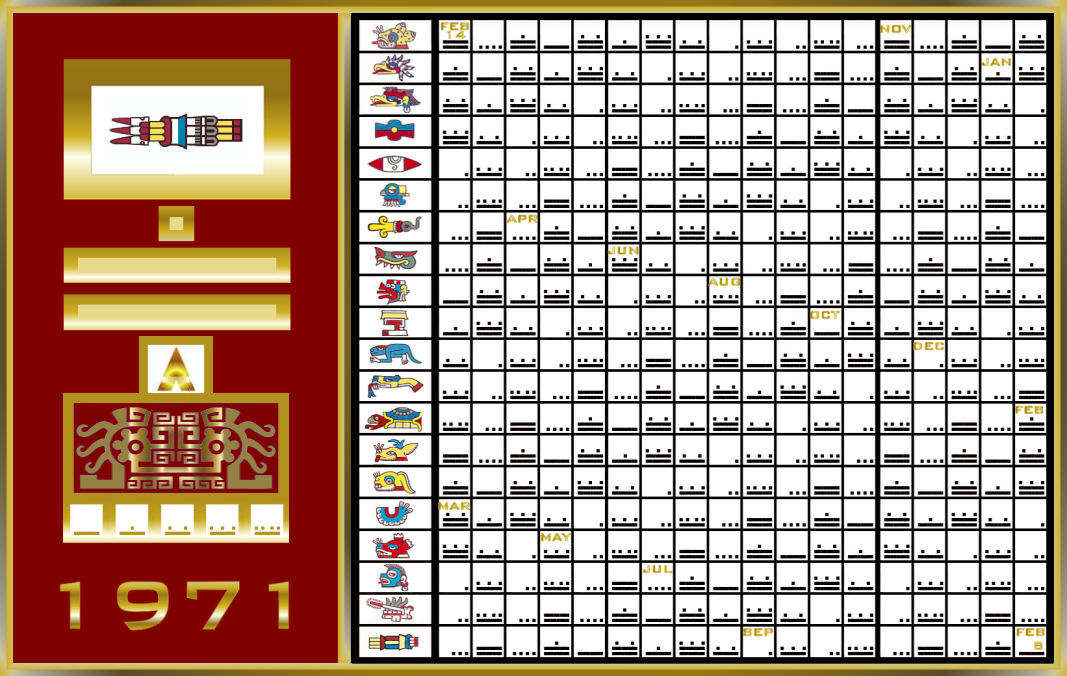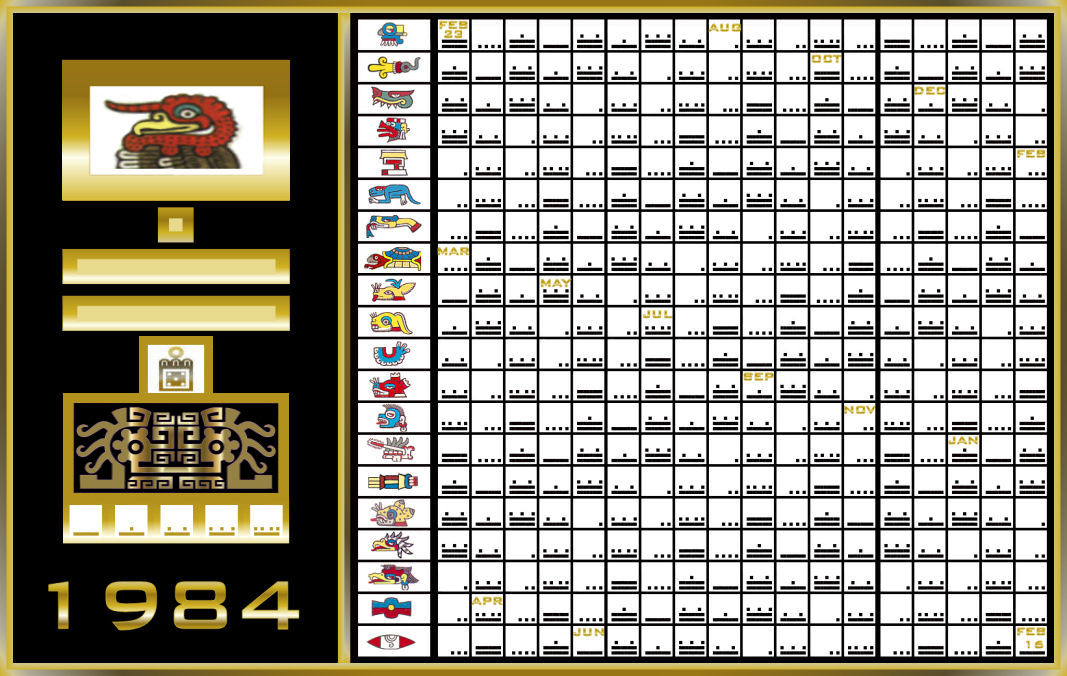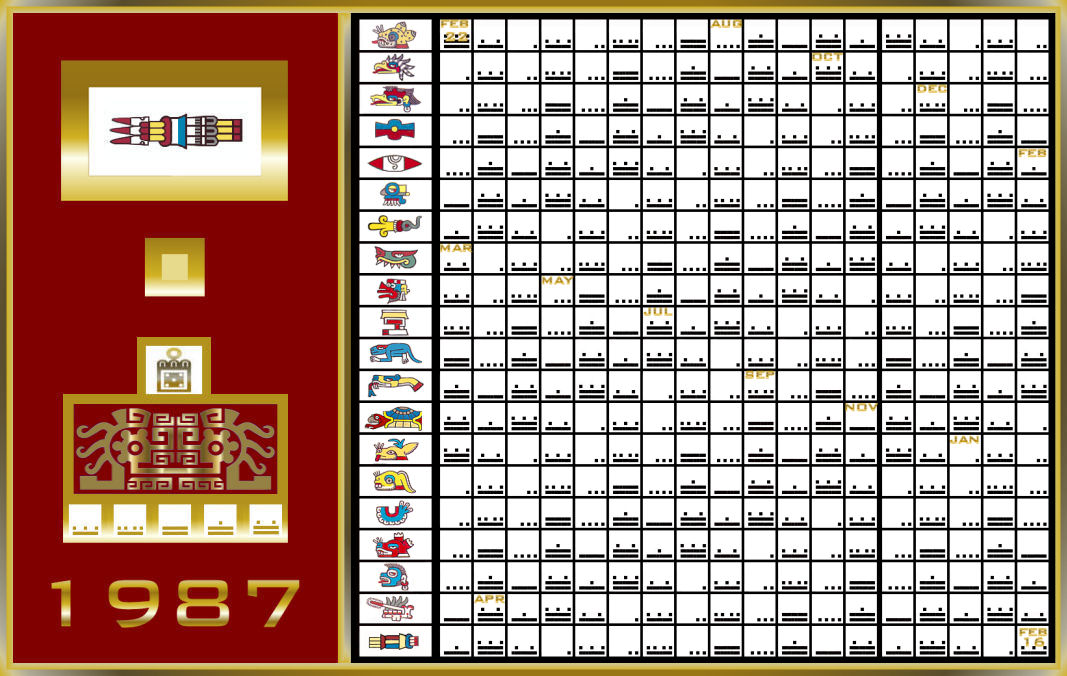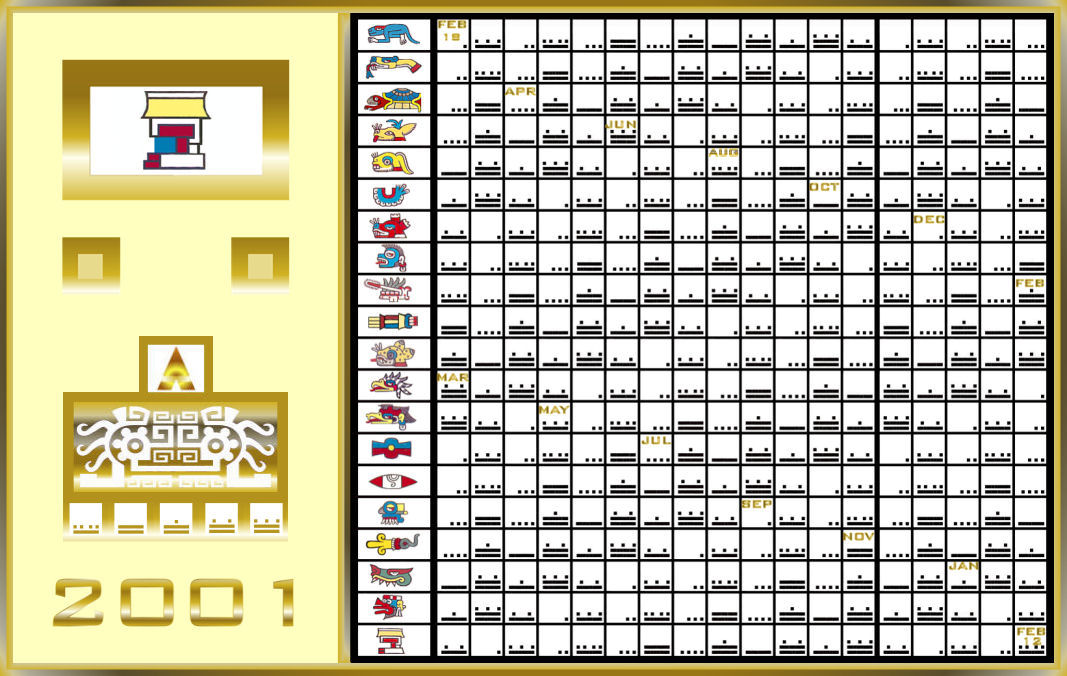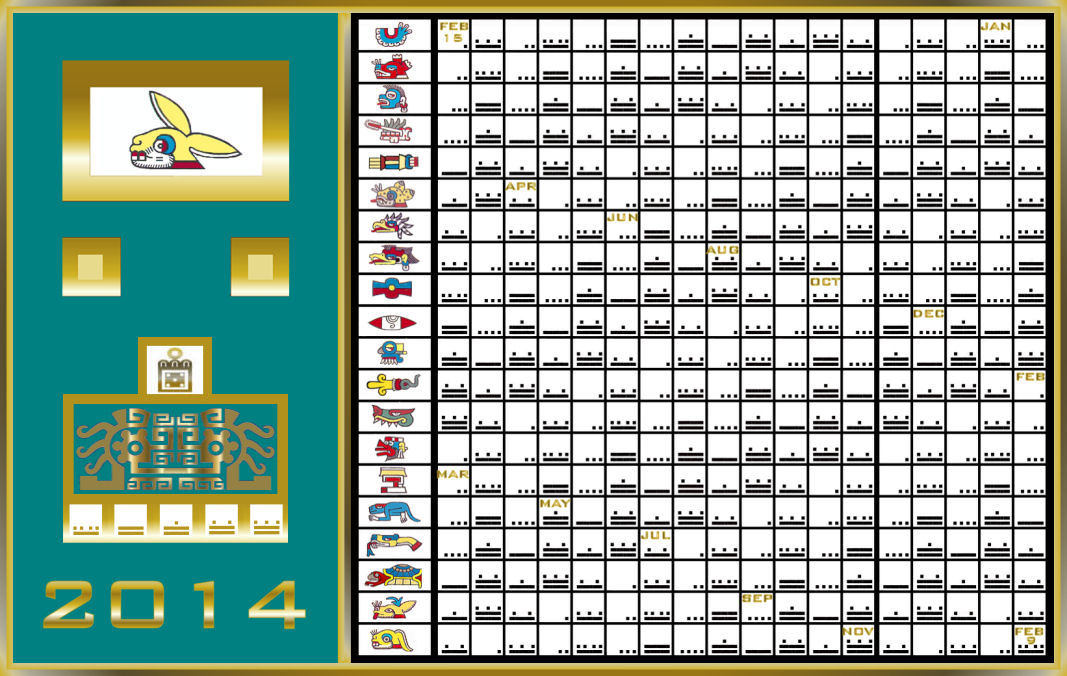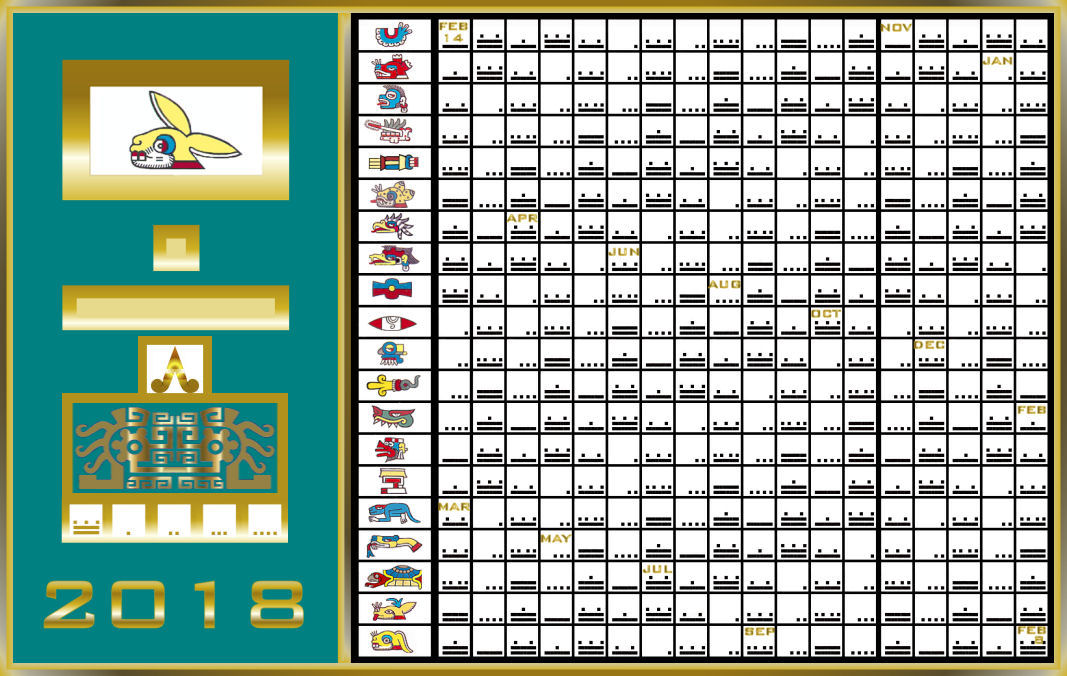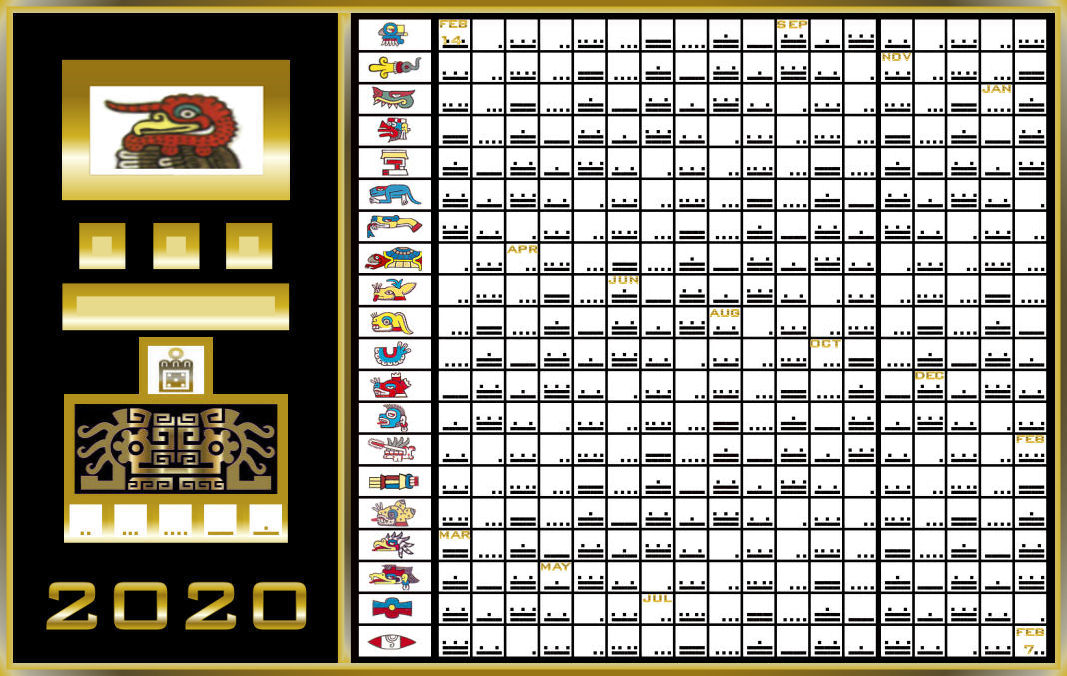Corrected Mesoamerican Calendars
Aztec Correlation: August 23rd, 1521 (August 13th Julian) Year: (3-House) Month: (2-Huey Micailhuitl) Day: (1-Serpent)
This list of 128-years of the Mexica-Azteca rendition of the Mesoamerican Calendar is based on the Surrender Date of Cuahatemoc to Spanish forces on the date of August 23rd, 1521 of the proleptic Gregorian Calendar. But it was actually August 13th, 1521 on the Julian calendar, which was then in use at that time in the Christian World. This correlation found between the two calendars is the most well documented in the whole basis of literary evidence that comes down to us from the Spanish records. In fact, it is this exact date correlation of "1-Serpent," to the Julian Date of August 13th, 1521 that the famous GMT-linear correlation is also based on, which in fact was a decision made by Eric S. Thompson to ensure that the documentation of the Mayan Calendar Chronology fit the more common ethnographic evidence that was always to be found with the more well documented Aztec Correlation.
The discrepancy that is found between the two correlations of the "Linear V.S. Corrected Counts," lies within the well-known documentation of the "New Fire Ceremony," which insists on the zenithal observance of the Pleiades at midnight, in the year of "2-Reed," of the Mexica-Azteca Count. The implication is that this ceremony was to end one cycle of 52-years and open another. The problem in recognizing the full implications of this ancient ceremony is that in order that it should happen exactly in every 52-years, and also at the same time when the Pleiades are at the midnight zenith, (which takes place at the time of our month of November) and still more while at the same time when the Tonalpohualli cycle is to be seen situated with the date of "4-Movement," as arriving perfectly to commence that specific 52-year ending point; that there must be a correction procedure involved to ensure the continuity of the timely ceremony that was in fact designed to realign the calendar cycles to the true cycles of natural seasonal time. The full details and implications of this ancient ceremony can be found in the Chapter above on the "New Fire Ceremony."
Because of the mathematical implications of this ancient realignment ceremony, and also with respect to the lack of fully accountable Spanish documentation on this procedure, unfortunately, confusion has reigned within the latest current studies that are held both by the general public and also by the more private scholarly sectors that are conducted in universities. Intuitively, most anyone who is even vaguely interested in the seasonal implications of the Mesoamerican Calendar can both sense, and understand that the 260-day cycle of the Tonalpohualli must be stopped for a time along with the other 20-day cycle of the "Metztli," which flowed and moved in an unbreakable synchronization with the counterpart 260-day Tonalpohualli so in order that this New Fire Ceremony could finally commence. This particular aspect of calendar synchronization was instituted by each individual tribal center, which in turn guaranteed that a certain day of the 260-day Tonalpohualli would open up a certain year at any point of the 52-year cycle. For instance, in the Mexica-Azteca Calendar, the year of 1-Reed always opened with the Tonalpoualli date of "13-Jaguar." This was true in the year of 1519 CE, just as surely as it was true in the most the recent year of 1987 CE. Later in that same year of 1-Reed, we find that the date of "1-Alligator," both was then as it is now, to commence exactly with the spring equinox. This timely alignment found between the date of 1-Alligator, and the spring equinox in the year of 1-Reed is specifically the result of the New Fire Ceremony Correction Procedure. (See years of 1935 and 1987 below in the calendar charts).
Evidence found and provided with the latest Mayan Counts, brought to us by Bishop deLanda also show that this same 1-Alligator / 1-Imix spring equinox alignment date had taken place in the Mayan Calendar as well, although more specifically in their year of "1-Manik," which is commensurate to the time of 1-Reed in the Aztec Count. This would seem to imply a 'corrected count' as well that would have been practiced by the Maya just before the Spanish Conquest. But the unrelenting argument then arrives to us from the notion of the more ancient "Classic Mayan Calendar," as being a strictly Linear composition in nature, and then this perspective is perpetually induced towards manipulating interpretations for the whole concept of the Mesoamerican Calendar at large throughout the ancient Mesoamerican world. In the view of this author, and according to a new concept and explanation of the calendar here at this website that is now being implemented, the two conflicting points of view should be comfortably integrated through the notion of a dual calendar composition with a previously implemented 'calendar matrix' that was historically created with respect to the Linear Count that would have operated within a coherent sequence to the ancient Corrected Count. Some details of this theory have already been published on this website, albeit though still somewhat vaguely. The theory is currently leaning heavily towards the notion that the Linear Count has more specific "sidereal (stellar) properties," of alignment and rectification, while the Corrected Count has a preeminent basis of solar and seasonal alignments for its rectification. Further details about the integration of these two different Mesoamerican Calendar Counts are still currently in progress here at this website by this author.
The 128-calendar tables found below were generated specifically with regards to the Corrected Count within the Mexica-Azteca rendition of the calendar. For this reason, we see the year cycle as always beginning in February, just as it did historically with respect to an agricultural spring cycle of planting and harvest. This is perfectly indicated by the 20-day Metztli cycles that reflect the seasonal attributes of the year. These 20-day cycles are indicated in the charts below, within the18-downward linear rows that fulfill 360-days in whole. The names of these various 18-Festivals can be found in the first chapter on "Mesoamerican Calendar," found above, while a more astrological comparison of these 18-cycles to the 12-fold zodiac that will be found in the "Mesoamerican Astrology," section above is still pending. After 360-days have been fulfilled, the so-called 5-unlucky days of the "Nemontemi," commence to end the year. However, in these charts, the Nemontemi of the year is found in the following year chart, which can be counted easily right into the first day of the New Year commencing with the following number found in the sequence of the 5-blank Nemontemi day indicators. These are intended to hold the day sign as well, just not visibly in this case. Although to all intents and purposes they might as well be counted as normal days, and for that matter, the Mesoamerican Calendar just as well should have one 25-day month to close the year - but that's just not the way they did it! The subject matter of these 5-days are very controversial, as they may have been observed at almost any point of the year by various tribes throughout the regions. The February dates for the 5-Nemontemi are specifically a Mexica-Azteca characteristic of seasonal alignment and are regarded as significant to this author with respect to the 21-years of personal observance that goes along with this correlation presentation.
Also with regards to the mysterious and controversial calendar alignments and appearances, it has been recently decided by this author that certain changes and transformations in appearance with regards to the signs should take place with respect to the investigators and their level of expertise. For this reason, intimidating and misunderstood aspects of the two signs of "Tecpatl," (Flint Knife), and "Miquiztli," (Death) have been transformed with their alternative sign renderings. For instance, it is well known that the true identity and meaning of the intimidating Flint Knife sign is to be found within its so-called 'ruler', which is the indigenous war god-concept of "Chalchiuhtotolin," meaning, 'Jeweled Fowl', which here is meant as a direct allusion to the colorful pageantry of the Turkey Bird as it was known in ancient Mexico and throughout those many lands as a symbol of the warrior, and the concerted efforts of self-promotion that are demonstrated by those in that field of endeavor. For that matter, the Turkey symbol offers a much warmer reception to the common concept of the year as it is presented in consistent 4-fold increments. There's no need for those of a less aggressive vein to have to contemplate the ridged meaning of the dreaded Flint Knife in relation to their personal birth date. However, for that matter, as it can be seen at the bottom of those Turkey Year Charts, the symbol of the Flint Knife was indeed left in its place so as not to overcompensate. Once again, these two symbols of the Turkey, and the Flint Knife are synonymous with one another.
Secondly, and even more importantly, is the transformation that was instigated with the Miquiztli (Death) sign into the implication of its shelled ruler of "Tecciztecatl," which the symbol of the Turtle or "Ayotl," takes the place of as a legitimate and inherited traditional symbol. See the section on "Mesoamerican Astrology," above for more details on this fact. In any case, the birth sign of "Ayotl" is always the most unlikely individual to volunteer such kinds of personal information for purposes that are related to astrology. Therefore, in the case that they do participate, it is intended and recommended that they get the break from the ever misunderstood (conceptual) sign of Death, as it was outlined within ancient Mesoamerica as a symbol of the midnight sun. For that matter, the truth is that the people born on this date are indeed really 'Turtles' in every sense of the word. This will be better understood with the promotion of this sign in this very recommended animal and reptile format that forsakes the simplistic and fatal conceptual symbol of Death, and it's forever misunderstood human implications. The rare and valuable traditional source of the Turtle tonalli sign can be found here on this webpage, which demonstrates the Codex Cospi and its variations on the 20-days.
http://www.famsi.org/research/graz/cospi/img_page23.html
Finally, there is the highly inaccessible information pertaining to the year or "Xihuitl," and its astrological influence in Mesoamerica, which was paired right along with a specific13-fold number that helped to complete a cycle of 52-years called, "Omepohaulxihuitl." If it were not for the extra resource offered to us through the ancient Chinese Year Signs, I do not personally feel that we will ever be able to clearly rectify the 4-archetypes of the Mesoamerican Year Signs. The realization of this annual astrological framework can only happen when we come to terms with the 52-year Aztec Correction Date Concept, and the beginning of each and every Aztec year in the month of February, which usually happens right along with the Chinese New Year; and basically right along with the change of every New Year found in our calendar as well. This is important, and not to be disregarded as folly. For this matter, in recognizing the various facets of similarity found between the 4-Aztec Year archetypes in relation to the 12-Chinese Year archetypes, a whole chapter (although somewhat still incomplete) has been dedicated to comprehending this inherent astrologic pattern found above within the Chapter called "Painted Jade." Reading some of this chapter will help in coming to terms with the meaning of the year sign in Mesoamerica. Although, it is probably true that the Mesoamericans had simply generated a general meaning for the 4-Year archetypes, and then probably merely merged those archetypes with the preceding 13-numbers. But by the same token, it is also true that in our modern world that there are in fact "add-on's," to be discovered, which are legitimate 'astrological bleed throughs', which can help with the ultimate integration of modern astrological knowledge within regards to this ancient primordial calendar, which in itself demands some degree of "reintegration" into the world anyway.
Therefore, with regards to the inclusion of the "3-modality arrows" images found below within the "Year Calendar Charts," simply compare the first Calendar Year Chart of 1900 CE to the Chinese Year of the RAT; the year of 1901 to the year of the OX; the year of 1902 to the year of the TIGER; 1903 to the year of the CAT - and so on, and so forth, throughout all of the 12-Chinese Year Signs, and backwards and forwards into time indefinitely, as these two year systems of the Chinese and the Aztec are by all means of practicality synonymous with one another.
Finally, this is all due to the addition of a series of intercalary dates added at the time of the "New Fire Ceremony," which should be thoroughly researched in the Chapter above with regards to understanding these "Year Calendar Charts." This author is responsible for the introduction of a theoretical 14th-intercalary day added at the end of each 520-year period (10 x 52-years). This extra date very well may be responsible for why we find that in the year of 1521 CE that the date of "1-Serpent," was found on the Gregorian date of August 23rd in the year of 3-House. In truth, the more common location of that date in the year of 3-House is to be found on the dates of August 21st, or the 22nd. Practically in every 520-years, it would be found on the 23rd of August in the year of 3-House, just as it was in 1521 CE. The reader can observe and verify this by going to the two Year Charts of 1938 and 1989 found below. This theory holds true except when various incremental changes found within the Gregorian calendar subvert any regular consistencies that can usually be found between the two measuring systems of the Gregorian and Aztec Calendars.
Lastly, with regards to these Year Charts in relation to what has become the more popular Linear Mayan Long Count, it is being advised here that one simply not choose one over the other, but rather compare the two at every turn of the way. Watch closely the progress of events and the people who partake in them, by acquiring the birth dates of all important political and famous people who are currently in and creating the news we see and read about. Currently, Wikipedia is supplying more and more birth date information, on more and more people all the time. By studying these people of prominence and the dates of their personal events, a great deal of information can be obtained about the nature of the Mesoamerican Calendar and its innate astrology, which is due for great improvements for its dissertation, and a more profound understanding of its available perceptual and revelation content. With this need, we do not shy away from exploring both systems of the Linear and Corrected Counts from ancient Mexico, but rather we embrace them both with an understanding of their interrelatedness, and source of origin. Many of these details have been explored within the pages of this website, while other details remain to be fully conceived and revealed later. There are currently available a couple of fine websites that provide calculators for the GMT 584,283 correlation. It is being suggested that a daily comparison is made with regards to this particular GMT correlation and the Year Chart Calendars provided below.
All Calendar Year Charts are Private Property. Copyright 2011. T.I.M.E. Do Not Deconstruct or Reproduce.
_
And [as for] the pregnant women who had been feared, if any of them gave birth to and bore a child; if a boy was born as her child, they named him Molpilli, Xuihtlalpil, Xiuhtzitzqui, Xiuhlti, Texiuh, Xiuhtlatlac, Quetzalxiuh, Xiuhquen. And if [it was] a girl, Xiuhnenetl, Xiuhcue, Xiuhcozol, etc.
Sahagun. Book VII Florentine Codex. p.31
And [as for] the pregnant women who had been feared, if any of them gave birth to and bore a child; if a boy was born as her child, they named him Molpilli, Xuihtlalpil, Xiuhtzitzqui, Xiuhlti, Texiuh, Xiuhtlatlac, Quetzalxiuh, Xiuhquen. And if [it was] a girl, Xiuhnenetl, Xiuhcue, Xiuhcozol, etc.
Sahagun. Book VII Florentine Codex. p.31
And [as for] the pregnant women who had been feared, if any of them gave birth to and bore a child; if a boy was born as her child, they named him Molpilli, Xuihtlalpil, Xiuhtzitzqui, Xiuhlti, Texiuh, Xiuhtlatlac, Quetzalxiuh, Xiuhquen. And if [it was] a girl, Xiuhnenetl, Xiuhcue, Xiuhcozol, etc.
Sahagun. Book VII Florentine Codex. p.31
_
And [as for] the pregnant women who had been feared, if any of them gave birth to and bore a child; if a boy was born as her child, they named him Molpilli, Xuihtlalpil, Xiuhtzitzqui, Xiuhlti, Texiuh, Xiuhtlatlac, Quetzalxiuh, Xiuhquen. And if [it was] a girl, Xiuhnenetl, Xiuhcue, Xiuhcozol, etc.
Sahagun. Book VII Florentine Codex. p.31
And [as for] the pregnant women who had been feared, if any of them gave birth to and bore a child; if a boy was born as her child, they named him Molpilli, Xuihtlalpil, Xiuhtzitzqui, Xiuhlti, Texiuh, Xiuhtlatlac, Quetzalxiuh, Xiuhquen. And if [it was] a girl, Xiuhnenetl, Xiuhcue, Xiuhcozol, etc.
Sahagun. Book VII Florentine Codex. p.31
In
order to continue this count past 2027, simply go above to the 1924 Year
Chart, and count 21, 22, 23, 24, 25, upon the adjacent 5-Nemontemi calculator, and the date of 2-Rain, in the year of 3-Flint will approach on the date of February 26th,
of the year 1924. Therefore, the 1924 Year Chart is commensurate to the undisclosed 2028 Year Chart, just as a typical 104-year period should be. Also notice, the year of 2000 added a leap date on February 29th, 2000, and by default the 14th -day correction principal reinforced the True Solar Date component of the Corrected Count. However, the Chinese Year Correlation is different with the year of 1924 being the "Rat," and the year of 2028 being the "Monkey," due to the inherent 156-year cycle found between the 12-fold Chinese Year Count, and the traditional 52-Year Count of ancient Mesoamerica.
of the year 1924. Therefore, the 1924 Year Chart is commensurate to the undisclosed 2028 Year Chart, just as a typical 104-year period should be. Also notice, the year of 2000 added a leap date on February 29th, 2000, and by default the 14th -day correction principal reinforced the True Solar Date component of the Corrected Count. However, the Chinese Year Correlation is different with the year of 1924 being the "Rat," and the year of 2028 being the "Monkey," due to the inherent 156-year cycle found between the 12-fold Chinese Year Count, and the traditional 52-Year Count of ancient Mesoamerica.
All original information Copyright. 2011 Matlactli Omome Cuauhtli / Tonal Inquiry Mesoamerican Experiences


